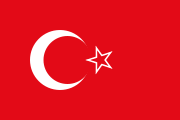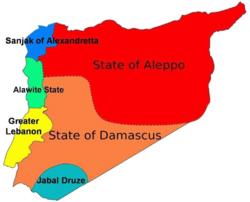Hatay State
|
|||||||||||||||||||||||||||||||||||||||||
Hatay State (Turkish: Hatay Devleti, Arabic: لواء الإسكندرونة), also known informally as the Republic of Hatay, was a transitional political entity that formally existed from September 7 1938 to June 29 1939 in the territory of the Sanjak of Alexandretta of the French Mandate of Syria. The state was annexed by the Republic of Turkey on June 29 1939 and transformed into the Hatay Province (excluding districts of Erzin, Dörtyol, Hassa) of Turkey.
Contents |
Background
Formerly part of the Halab province of the Ottoman Empire, the Sanjak of Alexandretta was occupied by France at the end of World War I and constituted part of the French Mandate of Syria. Turkey under Mustafa Kemal Atatürk refused to accept the Sanjak of Alexandretta to be part of the Mandate and, in a speech on 15 March 1923 in Adana, claimed, probably in projection to the Turkish Historical Thesis, that it was "a Turkish homeland for four hundred centuries" that "can’t be a captive at the hands of enemy"[1]. Turkish politics aimed at incorporating the Sanjak of Alexandretta when the French mandate of Syria would expire in 1935. Local Turks initiated reforms in the style of Atatürk's, formed various organisations and institutions in order to promote the idea of union with Turkey.
In 1936 Atatürk coined the name Hatay for the Sanjak of Alexandretta, and raised the issue of Hatay (Turkish: Hatay meselesi) at the League of Nations. On behalf of the League of Nations, representatives of France, United Kingdom, The Netherlands, Belgium and Turkey prepared a constitution for Hatay which established it as an autonomous sanjak within Syria. Despite some inter-ethnic violence, in the midst of 1938 an election to the local legislative assembly was conducted and it was convoked.
1938 elections
According to the official parliamentary elections on July 22 1938, there were 57,008 voters in the Sanjak, belonging to the following ethnic groups:
- Turks: 35,847
- Arab Alawis: 11,319
- Armenians: 5,504
- Arab Christians (Greek Orthodox): 2,098
- Arab (Sunni): 1,845
- "Others": 395
The parliament was not divided among party lines but along those of ethnicity. The 40 seats of the parliament were distributed as follows:
- Antakya: 14 Turks, 7 Arab Alawis, 2 Armenians, 2 Sunni Arabs, 1 Arab Orthodox Christian
- İskenderun: 3 Turks, 2 Arab Alawis, 1 Armenian, 1 Arab Orthodox Christian
- Kırıkhan: 5 Turks, 2 Armenians
- Total: 22 Turks, 9 Arab Alawis, 5 Armenians, 2 Sunni Arabs, 2 Arab Orthodox Christians
Allegations of electoral fraud
From the July 3 1939 issue of Time:
- “Hatay is a melting pot of Arabs, Kurds, Armenians, Alaouites, Greeks, Circassians and Turks. Of these, the Turks are most numerous, constituting 40% of the population. Taking a leaf from Führer Hitler's book and even improving on his methods, the Turks first asked for (and got) minority rights for their nationals in Hatay, next autonomy for the region, next ‘independence,’ with Turkish and French troops jointly ‘keeping order.’ At one time the late President Kemal Atatürk backed up his demands by massing troops along the Syrian border. At another time a League of Nations plebiscite was to be held in the district, but when most of the non-Turks banded together and it became obvious that the Turks could not win, the obliging French invited the League Commission to leave.”[2]
Robert Fisk wrote in a 2001 article for The Independent and his book The Great War for Civilisation: The Conquest of the Middle East that “The Turks trucked tens of thousands of people into the sanjak for the referendum and, of course, the ‘people’ voted to be part of Turkey”.[3]
Proclamation of independence
On September 6 1938 the constitution was adopted. It resembled strongly the constitution created by the League of Nations for the Sanjak of Alexandretta. The constitution defined the territory as an independent state called "Hatay Devleti" (Hatay State), divided into four districts (Antakya, İskenderun, Ordu (Yayladağı), Kırıkhan and Reyhaniye (Reyhanlı). Turkish was declared the state language, while French retained a status as a secondary language. Schools teaching Arabic could continue to do so.
On September 7 1938 the Hatay adopted a flag sketched by Kemal Atatürk. On February 6 1939 the Hatay legislative adopted all Turkish laws, and on March 13 1939 made the Turkish lira the official currency.
In popular culture
The Republic of Hatay was featured as one of the main locations in the 1989 film Indiana Jones and the Last Crusade. In the film, the Holy Grail is discovered in an ancient temple within Hatay, although the location used for the external shots of the temple is the Treasury of the ancient city of Petra, actually located in Jordan.
Aside from the name and location, most of the detail of Hatay within the movie is fictionalised - the flag is incorrect, and the state is shown as a monarchy with a Sultan, populated by Arabic-speakers, rather than a Turkish-speaking republic.
References
- ↑ History of Hatay (In Turkish)
- ↑ "Semitic Friends". Time Inc. (1939-07-03). Retrieved on 2007-02-09.
- ↑ Fisk, Robert (2001-06-02). "Why exiled Armenians blame the French for their dreadful secret". The Independent. Retrieved on 2006-12-03.
Sources
- Sökmen, Tayfur: Hatay'ın Kurtuluşu İçin Harcanan Çabalar, Ankara 1992, ISBN 975-16-0499-0
|
|||||||||||||||||||

